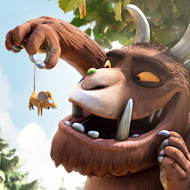There can’t be many parents who haven’t read Julia Donaldson’s The Gruffalo to their child at least 30 times. It’s that type of book – a winning combination of Axel Scheffler’s sumptuously detailed illustrations and Donaldson’s beautifully structured tale of an industrious mouse outwitting a succession of foes. It’s hard to believe that this modern-day classic is less than 20 years old.
Like so many of her stories it reads beautifully, like the lyrics of a folk song (due, in no small part, to her background as a songwriter for BBC Children’s TV, including the legendary Play Away) and is one of the few children’s books which bears repeated (and I mean REPEATED) reading. I say ‘reading’, but in actual fact I mean ‘performing’. You won’t get away with a half-hearted Gruffalo – well I couldn’t anyway!
I’m guessing that, like me, most Gruffalo ‘performers’ were a little concerned when they heard that it was to be made into a film, and then utterly relieved that the (Oscar-nominated) animation actually improved on the book. Following the second film’s TV premiere on Christmas Day 2011, my son watched both films at least once a day for over a month – often asking to watch them again as soon as they had finished.
The voice cast is uniformly superb, with James Corden perfect as the heroic mouse, and John Hurt, Tom Wilkinson and Rob Brydon relishing their roles as the owl, fox and snake respectively. Robbie Coltrane is the only actor in the world who could have played the Gruffalo, in my opinion, and he is joined in the sequel by Shirley Henderson, playing the eponymous Gruffalo’s Child.
 However, it was René Aubry’s wonderful score which first enchanted me, and so it was a real treat to watch the two films with a live accompaniment from the stunning Royal Northern Sinfonia at the Bridgewater Hall in Manchester. Before they began, conductor Terry Davies introduced a few of the key instruments – the percussion as the snake, piccolo as the owl – and we were shown a short film on how some of the key scenes were translated from page to screen.
However, it was René Aubry’s wonderful score which first enchanted me, and so it was a real treat to watch the two films with a live accompaniment from the stunning Royal Northern Sinfonia at the Bridgewater Hall in Manchester. Before they began, conductor Terry Davies introduced a few of the key instruments – the percussion as the snake, piccolo as the owl – and we were shown a short film on how some of the key scenes were translated from page to screen.
As the first feature started, I found myself watching the musicians, and not least the conductor who was following a score, the musicians, the large screen AND a smaller screen just above his score, indicating tempo and additional cues. However, I soon forgot they were all there. My son was rapt, as usual, and ducked down under my seat every time snake (Brydon) appeared. It was also great to hear the adults laugh at so many of the visual jokes and vocal performances – it sounded as though quite a few parents were watching for the first time.
As the credits rolled, just after Helena Bonham Carter’s soft narration finished, I was ready to watch them all over again.
By Chris Payne




